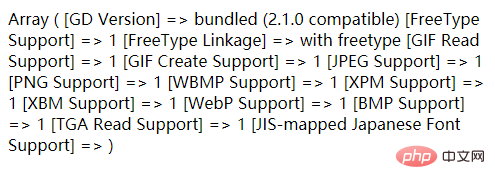 Backend Development
Backend Development
 PHP Problem
PHP Problem
 How to output images in PHP? (Detailed explanation of the legend)
How to output images in PHP? (Detailed explanation of the legend)
How to output images in PHP? (Detailed explanation of the legend)
In the previous article, I brought you "How to upload files in PHP? You’ll understand after reading it! 》, which introduces you in detail how to upload files in PHP. This article will take a look at the relevant knowledge of image processing in PHP. I hope it will be helpful to everyone!

Image processing is something that is often encountered in PHP work. We encounter many scenarios where images need to be processed, such as image verification codes, image watermarks, etc. In fact, the focus of learning image processing is to learn the functions of the GD system in PHP. Image processing in PHP requires the support of the GD library, so let's first take a look at the relevant knowledge about the GD library.
GD library
The GD library can be understood as a function library for creating graphics images. The GD library actually It is written in C language and can be used in PHP. In addition to PHP, it can also be used in Perl and other languages. The GD library provides many interfaces for processing images.
GD is used in PHP The library can draw various graphics images, statistical charts, and image verification codes on the page, which can also be implemented using the GD library.
The example is as follows:
<?php phpinfo(); ?>
After input, in the output result, if the two options shown below appear, it means that the current machine supports image processing through GD:

Or you can use:
<?php
print_r(gd_info());
?>After input, run it. If the output result is as shown in the figure below, it also means that the current machine supports processing through GD image.

If it is not installed, you can also just change the "extension=php_gd2.dll" item in the php.ini configuration file under the Windows system The previous comment deletion method is completed.
In PHP, the operation of processing images through the GD library is generally divided into 4 basic steps:
Create canvas
Draw image
Output image
Release resources
We will complete it through these four steps Now that you know the basic operations on images, let’s take a look at how to operate them.
Create canvas
All our drawing and image processing need to be completed on a background image, which is the canvas, which can be understood as For images, we have a temporary area in memory as a canvas to store image information. Future image operations will be performed on this area, which is the canvas.
imagecreate() and imagecreatetruecolor() are used to create canvas. Their syntax format is as follows:
imagecreate(int $width, int $height) imagecreatetruecolor(int $width, int $height)
Among them, $width It means that the width of the created canvas can also be understood as the width of the image. $height means that the height of the created canvas is also the height of the image.
Both of these two functions can be used to create a canvas, but the difference is that they can The range of colors accommodated varies.
The example is as follows:
<?php
$img = @imagecreatetruecolor(120, 20) or die('画布创建失败!');
?>Since a canvas is just created and there is nothing on it, the browser will not output the canvas, but it can be passed through imagesx() and imagesy( ) to get the width and height of the image:
<?php
$img = @imagecreatetruecolor(120, 20) or die('画布创建失败!');
echo '画布的宽度为:'.imagesx($img).'像素';
echo '<br>画布的高度为:'.imagesy($img).'像素';
?>Output result:

From this we have completed creating a canvas.
In addition to using the above two functions to create a canvas, you can also create images through files or URLs in the following ways:
##imagecreatefromgif()
: Create a new image through a GIF file or URLimagecreatefromjpeg()
: Create a new image through a JPEG file or URimagecreatefrompng()
: Create a new image through a PNG file or URL- ##imagecreatefromwbmp()
: Create a new image through a WBMP file or URL An image
Output imageIn the above example, we have successfully created the canvas, which is different in PHP Format images also require different functions for output. The different functions are as follows:
- imagegif()
: Output a GIF format image to the browser or File
- imagejpeg()
: Output a JPEG format image to the browser or file
- imagepng( )
: Output a PNG format image to a browser or file
Their syntax format is as follows:
imagegif(resource $image[, string $filename]) imagejpeg(resource $image[, string $filename[, int $quality]]) imagepng(resource $image[, string $filename])
其中,$image为创建的一个图像资源;$filename表示为参数,用来设置文件需要保存的路径。
示例如下:
首先我在根目录中已经保存了一个名为php.png的图像文件
<?php
header('Content-type:image/jpeg');
$image= imagecreatefrompng('php.png');
imagepng($image);
?>输出结果:

通过imagecreatefrompng()函数和imagepng()成功的输出了一个格式为png的图片。
释放图像资源
通过上述示例已经成功的输出了图片,在图片的资源使用完成后,通常需要释放图像处理时所占用的内存,那应该怎样操作呢?
在PHP中我们通过imagedestroy() 函数来释放图像资源,语法格式如下:
imagedestroy(resource $image)
其中$image表示需要释放资源的图像
示例如下:
<?php
header('Content-type:image/jpeg');
$image= imagecreatefrompng('php.png');
imagepng($image);
imagedestroy($image);
?>因为释放图像资源的操作是没有输出内容的,所以就不列出输出结果了。
推荐学习:《PHP视频教程》
The above is the detailed content of How to output images in PHP? (Detailed explanation of the legend). For more information, please follow other related articles on the PHP Chinese website!

Hot AI Tools

Undresser.AI Undress
AI-powered app for creating realistic nude photos

AI Clothes Remover
Online AI tool for removing clothes from photos.

Undress AI Tool
Undress images for free

Clothoff.io
AI clothes remover

Video Face Swap
Swap faces in any video effortlessly with our completely free AI face swap tool!

Hot Article

Hot Tools

Notepad++7.3.1
Easy-to-use and free code editor

SublimeText3 Chinese version
Chinese version, very easy to use

Zend Studio 13.0.1
Powerful PHP integrated development environment

Dreamweaver CS6
Visual web development tools

SublimeText3 Mac version
God-level code editing software (SublimeText3)

Hot Topics
 PHP 8.4 Installation and Upgrade guide for Ubuntu and Debian
Dec 24, 2024 pm 04:42 PM
PHP 8.4 Installation and Upgrade guide for Ubuntu and Debian
Dec 24, 2024 pm 04:42 PM
PHP 8.4 brings several new features, security improvements, and performance improvements with healthy amounts of feature deprecations and removals. This guide explains how to install PHP 8.4 or upgrade to PHP 8.4 on Ubuntu, Debian, or their derivati
 7 PHP Functions I Regret I Didn't Know Before
Nov 13, 2024 am 09:42 AM
7 PHP Functions I Regret I Didn't Know Before
Nov 13, 2024 am 09:42 AM
If you are an experienced PHP developer, you might have the feeling that you’ve been there and done that already.You have developed a significant number of applications, debugged millions of lines of code, and tweaked a bunch of scripts to achieve op
 How To Set Up Visual Studio Code (VS Code) for PHP Development
Dec 20, 2024 am 11:31 AM
How To Set Up Visual Studio Code (VS Code) for PHP Development
Dec 20, 2024 am 11:31 AM
Visual Studio Code, also known as VS Code, is a free source code editor — or integrated development environment (IDE) — available for all major operating systems. With a large collection of extensions for many programming languages, VS Code can be c
 Explain JSON Web Tokens (JWT) and their use case in PHP APIs.
Apr 05, 2025 am 12:04 AM
Explain JSON Web Tokens (JWT) and their use case in PHP APIs.
Apr 05, 2025 am 12:04 AM
JWT is an open standard based on JSON, used to securely transmit information between parties, mainly for identity authentication and information exchange. 1. JWT consists of three parts: Header, Payload and Signature. 2. The working principle of JWT includes three steps: generating JWT, verifying JWT and parsing Payload. 3. When using JWT for authentication in PHP, JWT can be generated and verified, and user role and permission information can be included in advanced usage. 4. Common errors include signature verification failure, token expiration, and payload oversized. Debugging skills include using debugging tools and logging. 5. Performance optimization and best practices include using appropriate signature algorithms, setting validity periods reasonably,
 PHP Program to Count Vowels in a String
Feb 07, 2025 pm 12:12 PM
PHP Program to Count Vowels in a String
Feb 07, 2025 pm 12:12 PM
A string is a sequence of characters, including letters, numbers, and symbols. This tutorial will learn how to calculate the number of vowels in a given string in PHP using different methods. The vowels in English are a, e, i, o, u, and they can be uppercase or lowercase. What is a vowel? Vowels are alphabetic characters that represent a specific pronunciation. There are five vowels in English, including uppercase and lowercase: a, e, i, o, u Example 1 Input: String = "Tutorialspoint" Output: 6 explain The vowels in the string "Tutorialspoint" are u, o, i, a, o, i. There are 6 yuan in total
 How do you parse and process HTML/XML in PHP?
Feb 07, 2025 am 11:57 AM
How do you parse and process HTML/XML in PHP?
Feb 07, 2025 am 11:57 AM
This tutorial demonstrates how to efficiently process XML documents using PHP. XML (eXtensible Markup Language) is a versatile text-based markup language designed for both human readability and machine parsing. It's commonly used for data storage an
 Explain late static binding in PHP (static::).
Apr 03, 2025 am 12:04 AM
Explain late static binding in PHP (static::).
Apr 03, 2025 am 12:04 AM
Static binding (static::) implements late static binding (LSB) in PHP, allowing calling classes to be referenced in static contexts rather than defining classes. 1) The parsing process is performed at runtime, 2) Look up the call class in the inheritance relationship, 3) It may bring performance overhead.
 What are PHP magic methods (__construct, __destruct, __call, __get, __set, etc.) and provide use cases?
Apr 03, 2025 am 12:03 AM
What are PHP magic methods (__construct, __destruct, __call, __get, __set, etc.) and provide use cases?
Apr 03, 2025 am 12:03 AM
What are the magic methods of PHP? PHP's magic methods include: 1.\_\_construct, used to initialize objects; 2.\_\_destruct, used to clean up resources; 3.\_\_call, handle non-existent method calls; 4.\_\_get, implement dynamic attribute access; 5.\_\_set, implement dynamic attribute settings. These methods are automatically called in certain situations, improving code flexibility and efficiency.





